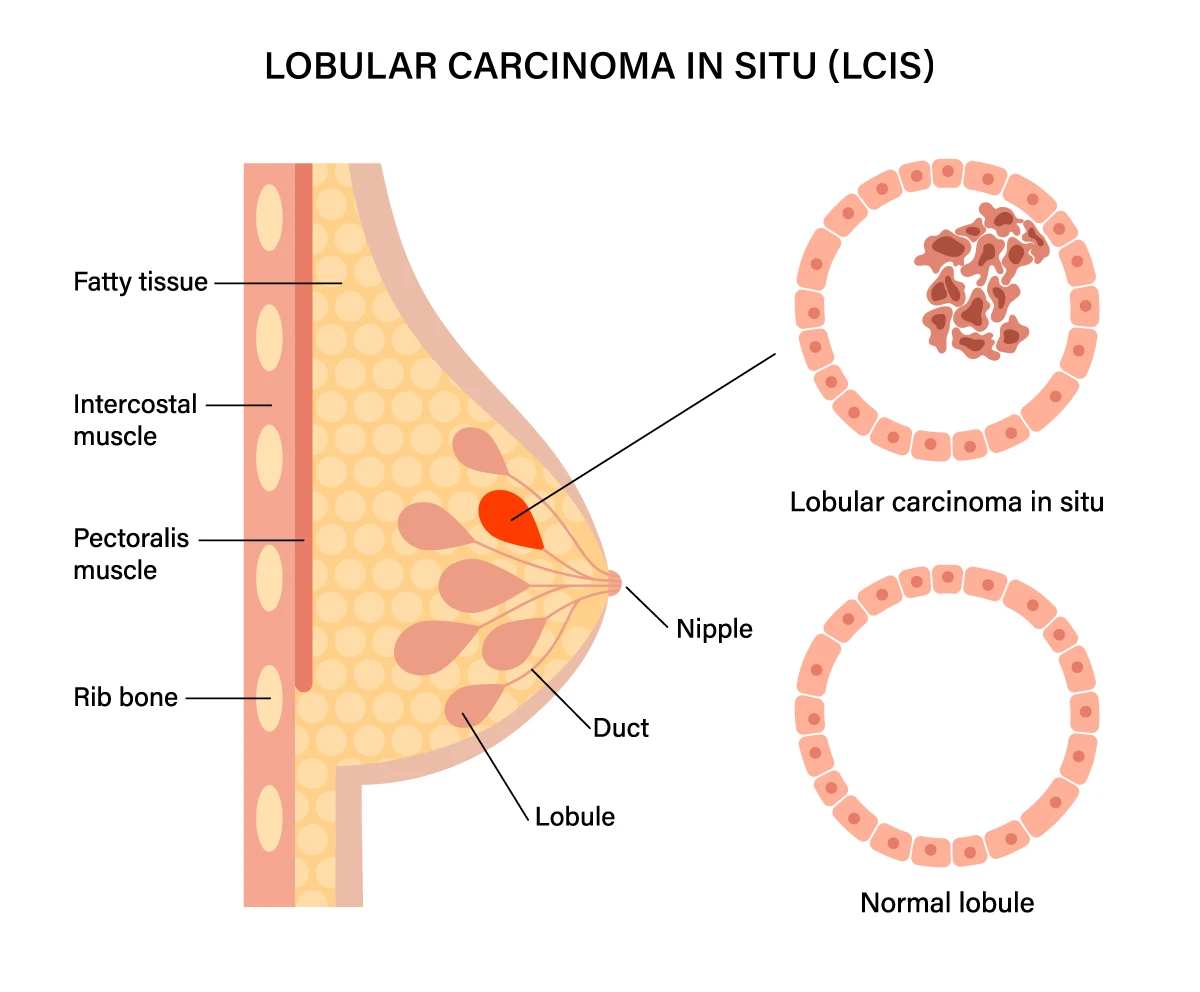Lobular carcinoma in situ (LCIS)
Find a cancer specialistLobular carcinoma in situ (LCIS) is a noncancerous condition where abnormal cells form in the milk ducts of the breast. While LCIS isn't cancer, it is a risk factor for developing breast cancer.
The team of cancer specialists at Advocate Health Care are here to support you through your LCIS diagnosis and treatment. We also make it easy to get the care you need with convenient locations throughout Chicagoland.
What is LCIS?

Lobular carcinoma in situ (LCIS) is breast condition where noncancerous cells grow inside the milk glands of the breast.
Although LCIS is considered stage zero breast cancer, it’s still grouped with other types of breast cancer ;because it can significantly increase your risk. Women are more likely to get LCIS but it can occur in men, too.
With LCIS, the abnormal cancer cells grow within the lining of a breast milk gland (lobule). These abnormal cells don’t spread beyond the gland. Although LCIS is non-invasive, regular monitoring and self-exams are important. Your doctor may, in some cases, recommend preventive measures like a mastectomy or surgery.
LCIS risk factors
Several factors, such as age, family history and hormonal factors may increase the risk of developing LCIS.
If you have a family history of breast cancer, genetic testing might be a good option for you to determine your risk. Through genetic testing, you can find out if you have gene mutations that may increase your risk.
Other risk factors include:
- Age: Women between the ages of 40-60 are more likely to develop LCIS, although it can occur at any age.
- Personal history of breast cancer: If you have previously been diagnosed with breast cancer in one breast, you may have an increased risk of developing LCIS in the other breast.
- Hormonal factors: Factors that affect hormone levels, such as early menstruation, late menopause, never giving birth or having a first child after the age of 30, and using hormone replacement therapy for an extended period, may increase the risk of LCIS.
- Dense breast tissue: Women with dense breast tissue, as seen on mammograms, have a higher risk of developing both LCIS and invasive breast cancer.
- Family history: A personal or family history of breast cancer, particularly in parents, siblings and children, can increase the risk of LCIS.
LCIS symptoms
LCIS doesn't cause any noticeable symptoms because it's confined to the lobules of the breast. Most cases of LCIS are detected through a biopsy for an abnormal lump or an abnormal finding on a mammogram.
However, there might be signs that could indicate an issue, including:
- Breast lump
- Nipple discharge
- Changes in breast appearance
- Breast pain or tenderness
If you notice any changes in your breasts or experience any concerning symptoms, schedule an appointment with your doctor for further evaluation.
LCIS diagnosis
Diagnosing LCIS can be tricky since it typically doesn't cause symptoms. Instead, it's often discovered during a biopsy or mammogram. Any abnormalities seen on a mammogram will be further evaluated with a core needle biopsy.
A core needle breast biopsy removes a small tissue sample through a thin, hollow needle from the area where an abnormality was seen on a mammogram. A pathologist will then determine whether the tissue is benign or cancerous to confirm a diagnosis of LCIS.
LCIS treatment
Your LCIS treatment will be personalized to you. Your doctor will consider your overall health and personal preferences, along with any risk factors you may have.
Treatment for LCIS involves one of the following approaches:
- Risk-reducing medications: Selective estrogen receptor modulators or aromatase inhibitors may be prescribed to block estrogen receptors in the breasts. This helps reduce your risk of developing invasive breast cancer.
- Observation: Since LCIS is noncancerous, regular checkups and monthly self-exams are the most used treatment option. Your doctor may also suggest annual mammograms to check for any changes in the breast tissue.
- Preventive mastectomy: The removal of one or both breasts to reduce the risk of developing invasive breast cancer. Skin-sparing and nipple-sparing mastectomies may be offered, depending on the proximity of the LCIS to those structures.
- Surgical treatments: A lumpectomy may be an option, where your surgeon removes any cancerous and abnormal tissue, some healthy tissue and lymph nodes under the arm. After surgery, your doctor will deliver radiation therapy into an open incision.
Are you at risk for breast cancer?
Knowing your chance of developing breast cancer can help you plan a routine screening schedule. Our breast health quiz estimates your five-year and lifetime risk and gives you an idea of what to do next based on your results.
Get care
We help you live well. And we’re here for you in person and online.